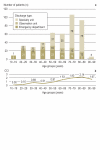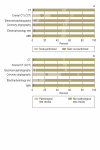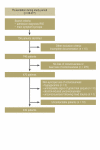Patients with syncope in a German emergency department: description of patients and processes
- PMID: 22334828
- PMCID: PMC3278749
- DOI: 10.3238/arztebl.2012.0058
Patients with syncope in a German emergency department: description of patients and processes
Abstract
Background: We studied the characteristics and resource utilization of patients with syncope in a German emergency department (ED).
Methods: We carried out a single-center retrospective analysis of patients with syncope who presented to the ED of the Klinikum Nürnberg (a municipal hospital in Nuremberg, Germany).
Results: Among the 28 477 patients who presented to the ED from 15 May 2009 to 30 September 2009, 440 (1.5%) presented with syncope. Their mean age was 62 years (standard deviation, 20 years); 50.4% were women, 43.4% were over age 70, 11.8% had cardiogenic and 4.8% neurological syncope, and 18.2% had more than two comorbid conditions. 20.7% were discharged after evaluation in the ED, 14.1% were brielfly hospitalized in the ED's clinical observation unit, and 56.6% were admitted to one of the hospital's specialty wards. 8.6% left the ED against medical advice. All of the syncope patients were evaluated by history-taking, physical examination, and 12-lead electrocardiogragraphy (ECG); ECG revealed abnormal findings in 36.4% of patients. Nearly all patients also underwent laboratory testing, which revealed hyponatremia (a serum sodium concentration under 130 mmol/L) in 5.9% and a serum creatinine level above 2 mg/dL in 5.3%. Many underwent technology-intensive tests such as cranial computed tomography (129 patients), but these tests only rarely yielded abnormal findings (3.1%). 27% of the syncope patients underwent Doppler ultrasonography of the vessels supplying the brain, with abnormal findings in 6.7% of cases. (Orthostatic testing was performed in 14.5% of the patients and was positive in 26.6%.)
Conclusion: Many patients presenting with syncope to a German ED are elderly, and multiple comorbidities are common. Technology-intensive testing in patients with syncope has a low diagnostic yield and consumes resources. The introduction of standards for the evaluation of syncope in the ED would be helpful.
Figures



Comment in
-
The investigation of syncope: strengths and weaknesses of emergency medicine.Dtsch Arztebl Int. 2012 Jan;109(4):56-7. doi: 10.3238/arztebl.2012.0056. Epub 2012 Jan 27. Dtsch Arztebl Int. 2012. PMID: 22334827 Free PMC article. No abstract available.
-
Consider European guidelines for syncope.Dtsch Arztebl Int. 2012 Jun;109(26):475; author reply 476. doi: 10.3238/arztebl.2012.0475a. Epub 2012 Jun 29. Dtsch Arztebl Int. 2012. PMID: 22833758 Free PMC article. No abstract available.
-
Unanswered questions.Dtsch Arztebl Int. 2012 Jun;109(26):475-6; author reply 476. doi: 10.3238/arztebl.2012.0475b. Epub 2012 Jun 29. Dtsch Arztebl Int. 2012. PMID: 22833759 Free PMC article. No abstract available.
References
-
- Kapoor WN. Syncope. N Engl J Med. 2000;343:1856–1862. - PubMed
-
- Moya A. Guidelines for the diagnosis and management of syncope (version 2009): The Task Force for the Diagnosis and Management of Syncope of the European Society of Cardiology (ESC): Developed in collaboration with, European Heart Rhythm Association (EHRA)1. European Heart Journal. 2009;30:2631–2671. - PMC - PubMed
-
- Grossman SA, Babineau M, Burke L, et al. Do outcomes of near syncope parallel syncope? Am J Emerg Med. 2010 epub ahead of print. - PubMed
-
- Soteriades ES, Evans JC, Larson MG, et al. Incidence and prognosis of syncope. N Engl J Med. 2002;347:878–885. - PubMed
MeSH terms
LinkOut - more resources
Full Text Sources
Medical

